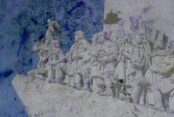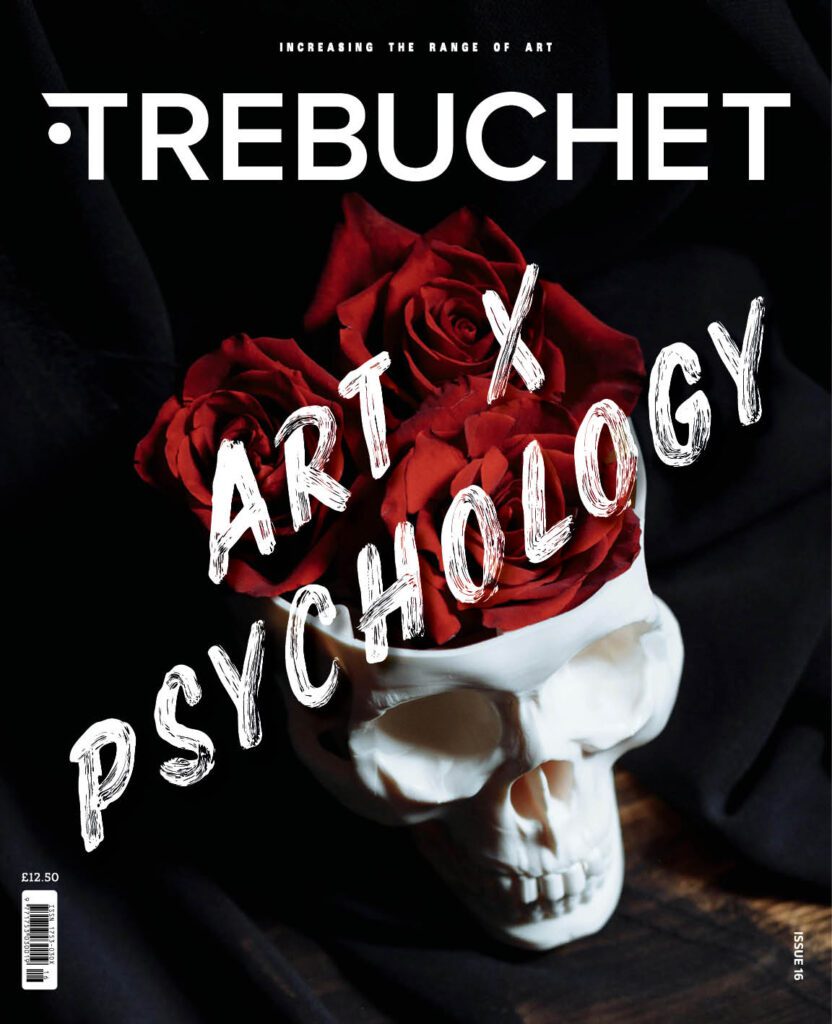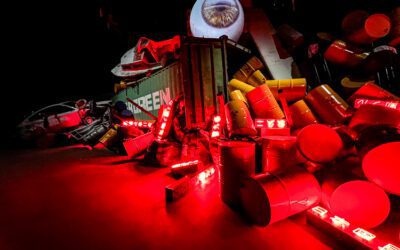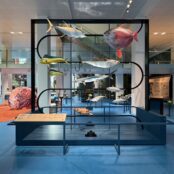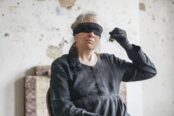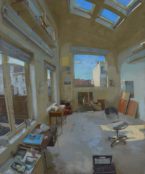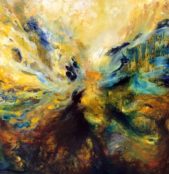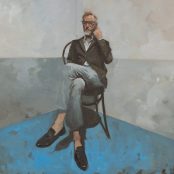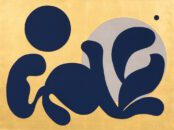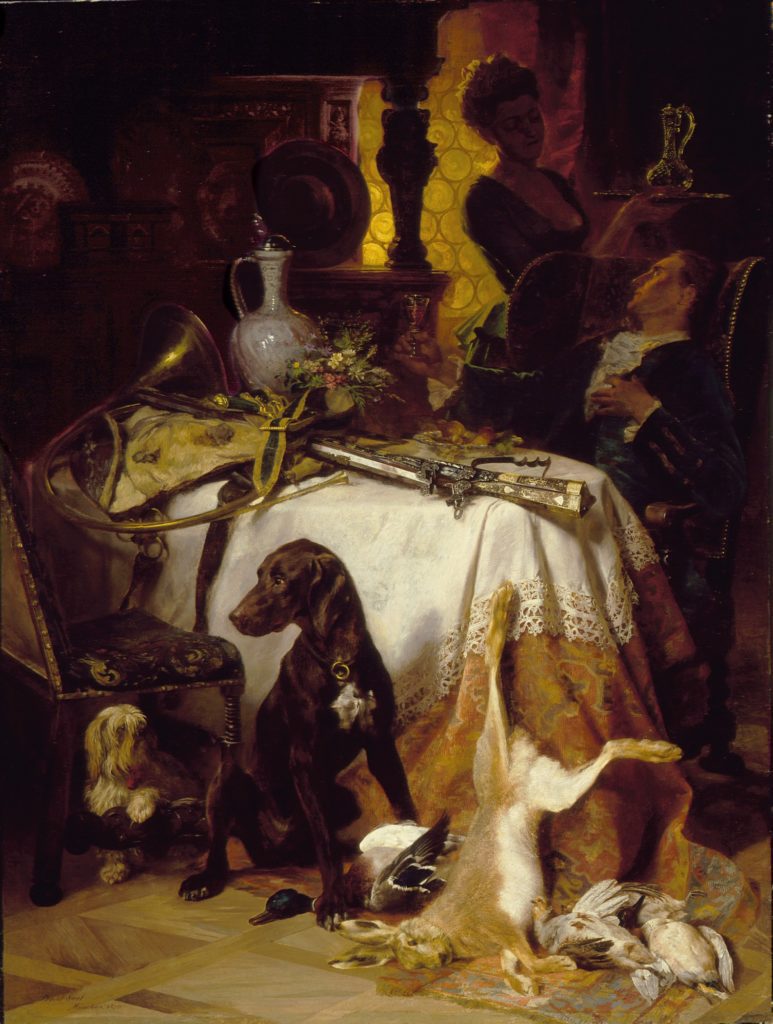Flowing with the richly garbed river that is miart patrons, trade stands erupt with theme and colour, snapshots of clientele, taste and above all optimism. As if through a mechanical camera’s ever-poised shutter, brash sexual images wink brazenly into view before shimmering suggestively onwards with each virginal white booth wall to yet another contained and curated collection similarly exploding with an adrenaline-like rush of names, textures, and contexts to turn us on.
Few cities can boast the unique package of art, history and architecture that is modern Milan. While for some art tourists it’s about visiting the classics, for others it’s discovering the new. So does Milan trade on history or vision? Was the art actually any good when Trebuchet wended its way through that northern city for Milan Art Week 2025?
An art fair is a chance to judge the promise of what defines art in major locations like New York, Cape Town, and of course the major cities of Italy. Each gallery bets on what the Milan crowd wants this year, while also trying to best demarcate their own patch.
So what is the harmonious overture of miart and how does it connect with Rauschenberg? Nicola Ricciardi, miart Director, explains;
“I believe that there is serendipity which started from an acquisition that I made at miart 2024. I found a beautiful photograph of Rauschenberg from 1951. It was a picture of the sneakers of Rauschenberg that I have now in my living room. When you buy art you want to study its background in depth so you can understand the context. I took out all the books I had, including the beautiful Calvin Tomkins biography, and I realised that Rauschenberg has a lot to do with what I do at miart. He was the link, physically, the link between modern and contemporary art. And miart is a pairing of modern and contemporary art.
He was a great collaborator. And I do feel that I am also a collaborator. So there was many things that reminded me of Rauschenberg work when I was thinking about miart2025. So I had this crazy idea, why don’t we do a whole edition dedicated to Rauschenberg work since 2025 is his 100 year anniversary, in the spirit of collaboration? So the galleries in Milan, the Rauschenberg foundation, and many other collectors, foundations and institutions have all contributed and collaborated on miart. I am so happy, I mean there are so many shows and people are busy this time of year, but people spend a lot of time with us, and have given us so much.”
There’s nothing like a centenary to establish contexts (or in some cases confer them). It’s a significant point when it comes to contemporary art and modernism. Despite Italy having successfully remade itself after the war the pull of Futurism remains. Marinetti, a complex and controversial figure because of his alignment with Fascism, looms large to this day in the city’s foundations and façades. Italians too are complex, and history lives with them. In the unassuming patter of current conversation there remain traces of SPQR and unquenched dreams. It’s a quality to admire, to possess a sense of purpose and rightful destiny.
For the 2025 edition Rauschenberg isa pivot point for showcasing both painting and multimedia art, the link between modernist art of the 1940s and the individuation which franks contemporary art. Mixed media and conceptual, there are a lot of signifiers in Rauschenberg’s works that anticipated where art would eventually move and several galleries around Milan are showcasing his works as if they were created yesterday. As a celebration of his centenary year the 2025 ninth edition of miart assembles museum exhibitions, talks and projects reflecting Rauschenberg’s ahead-of-his-time commitment to collaboration and syncretic ideas. The fair’s theme of ‘among friends’ projects this with galleries and institutions working together to enhance the city’s vision for artistic re-growth. A vision that’s coming into sharp focus in 2025, with highlights including John Giorno at the Triennale di Milano (until 14 April), Typologien at Fondazione Prada (14 June), the portal section of the miart (6 April), Nico Vascellari’s Pastoral at Palazzo Reale (2 June) and both Yukinori Yanagi and Tarek Atoui at Pirelli HangarBicocca (27/20 July).
One thing Milan does exceptionally well is to create exquisite art spaces. The Triennale di Milano as a cultural institution (established in 1923) dedicated to design and architecture with its high ceilings, sculptural use of natural light and floating walkways is impressive in its own right. Part of the Triennale’s collection is its archive which presents its extensive ‘historical memory’ through books, pamphlets and other media. It is the perfect place to host the work of iconic multimedia artist (and Rauschenberg collaborator) John Giorno.
Giorno’s synthesis of poetry and visual art has been heralded as a turning point in postmodern and contemporary art. A labour of LOVE brings together Giorno’s pamphlets and his Dial-A-Poem work (1968-2019). Originally, Giorno stencilled and advertised his Dial-a-Poem in New York however, in Milan, an unassuming plinth holds a red telephone. Part of the fun is watching people decide whether it’s a symbolic installation to accompany the poems shown in vitrines; however, as soon as the first person uses the telephone everything changes. The work and artist capture the spirit of the 1960s (and even that precursor to modern music streaming Dial-a-Disc) when artists were pushing the boundaries of what could be considered art. From something defined by an institutional frame of mind, by people who studied, theorised and espoused traditional modes of expression and appreciation, to something that could be encountered in the everyday by anyone. The artist as Everyman, and every man or woman an artist. The Dial-a-Poem project can be accessed by anyone at anytime, like water, electricity, pop music, or any other human need. What is surprising is that the quality of the poems and performances are actually very good. They don’t need to be for the work to function but seeing visitors engaged to tears is impressive. You can’t choose what poem you receive by entering a random number but, as with Giorno randomly distributing poems on roller skates throughout New York, somehow and quite often, the right poem finds the right person.
If Giorno’s work is a celebration of the individual then typologien at Fondazione Prada questions how people, society and history can uniquely capture individuals and frame them as types. The conceit of the exhibition is to encapsulate roughly 100 years of German photography as an exercise in flat typology, giving a linear view of social (industrialisation, modernism, capitalism) and historical (wars and post-wars) events through photography captured during that time. What made the exhibition interesting was how polarising it was for those attending. It’s invigorating when art slips the sleepy embrace of the appreciative – though barely perceptible – nod.
For some, the collection of works from Linnaean typology, to Richter’s Holocaust photos (assumedly from his atlas project), to the industrial epics of Struth and Gursky, was a carefully constructed view of German photography where, as curator Susanne Pfeffer puts it: ‘only through juxtaposition and direct comparison is it possible to find out what is individual and what is universal, what is normative or real’ (website). However, for others this accumulation of diverse intentions might be better titled ‘forced perspective’.
Putting all the works under a single aegis creates a through line that in many cases minimises or encages the intentions of each photographer, and more importantly their subjects. A context that while easy enough to escape does create an obstacle to the appreciation of each image. For instance many viewers may not consider all the photographs examples of German (read national) photography, nor that the nature of German photography is about typologies. The fourth wall here is also noteworthy: why emphasize German photography during Milan art week? Is there something particular about German and Italian collaboration (past or present) that is being explored here?
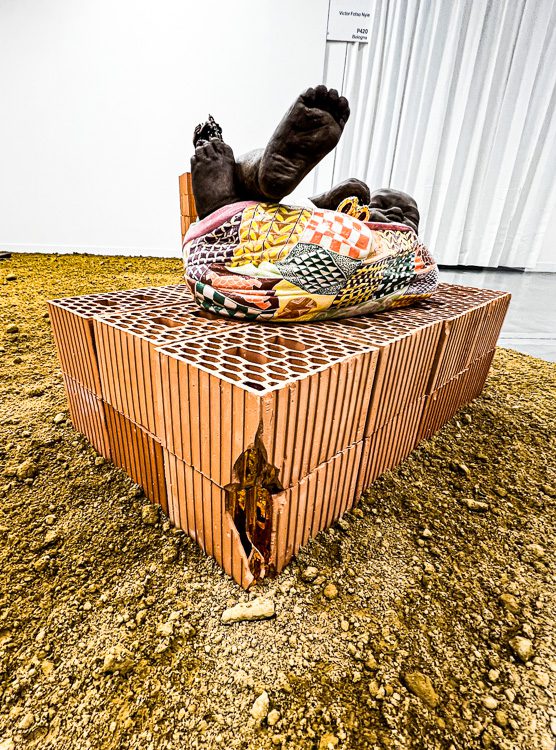
If Typologien raises the awareness of nationality in art then the portal section of miart highlights multidisciplinary and multicultural collaborative creative tendencies by showing artists with a global outlook. The artist Victor Fotso Nyie, whose sculptural installations blend Cameroonian, African and capital signifiers with exemplary flair, is worthy of mention In one piece quasi-industrial honeycomb-like bricks were cracked open to show golden ‘nectar’ atop of which a baby lay swaddled in traditionally influenced cloth, all the pieces in the section lie on a bed of specially selected soil from the river Po. Nyie has lived in Italy for a number of years so it’s easy to read his work as a fertile mixture of both his personal history and his current home. It’s a story which many travellers can appreciate well.
No less rooted in history is the triumphant work of Nico Vascellari’s epic Pastorale at the Palazzo Reale. Dominating the Sala delle Cariatidi, a room only partially restored since the Allied bombing of 1943, Pastorale is a large conceptual installation where a vast expanse of soil surrounds a metal structure that intermittently sprays seeds onto that soil. The soil is hydrated at various points so that over the course of the exhibition native weeds will grow creating a natural glade in the once regal palace. Vascellari speaks about the theme of resilience and how within this bombed room, which has been left with scars showing, things will nevertheless grow.
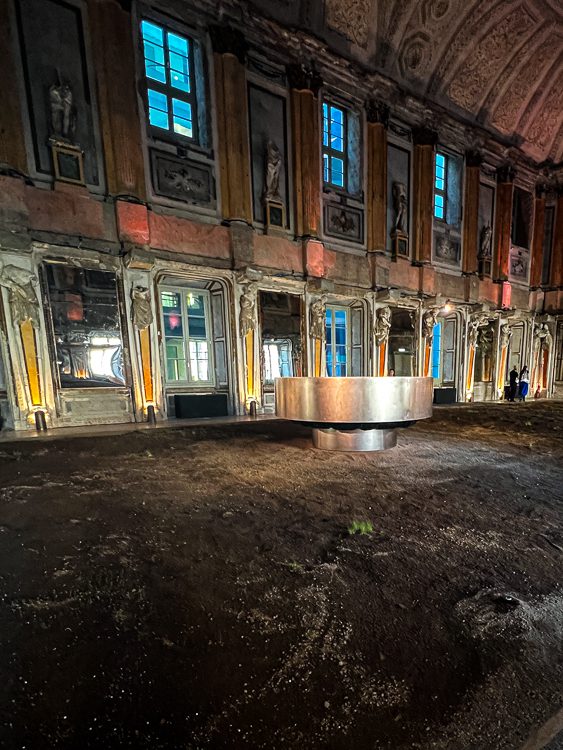
Seen in April the expanse of earth looks like a battlefield, the shining metallic seed dispenser could be a half-buried bomb or aircraft fuselage, which under pressure builds to explosive release with a cataclysmic noise. Later in the year the weeds will have grown, and perhaps bloom. The title Pastorale takes its cues from Beethoven, the idea of the natural, and the human need for the triumph of the natural. The palace walls are covered in idyllic images of natural scenes, ordered bliss for aristocrats waiting their turn in what was a seat of power in Northern Italy.
The metal structure reminds us of Futurists Marinetti and the lesser known Tullio Crali (who lived in Milan from 1958 until his death in 2000) whose shamanic visions of a technological future echo to this day with a frightening beauty. The dissonance between metal, bare soil and weeds marks Pastorale as a complete work, solidifying Vascellari’s reputation as a first rank artist in the full flush of confident inspiration.
As it goes through its lifecycle Pastorale is something to return to, to revisit, and to admire the extent of what art today may achieve. Similarly, no art sojourn to Milan would be complete without visiting Pirelli HangarBicocca (PHB). Renowned for hosting shows of historic importance since opening in 2004 they’ve held iconic exhibition after iconic exhibition and both current artists Yukinori Yanagi and Tarek Atoui are happily for us no exception.
Tarek Atoui’s sound and sculptural installation Improvisations in 10 days (featured in Trebuchet 17) is on the floor with a number of wires and pipes connecting esoteric looking machines each of whom react to, or create, changes in the environment that are then amplified by speakers, resonant surfaces, and more unusual mechanisms. In part the idea behind his work is that while things work in concordance with each other the nature of each part of the process changes a ‘fact’ into something particularised, though no less factual. While clearly the sonic aspect of the work is paramount, what strikes many visitors is just how visually appealing his installations are. The ordered network of connections, while distinctly mechanical, have an organic and considered structure making you feel that you’re inside a ‘body’, a living assemblage that has its own intent, purpose, past and future. Almost as though there was a larger consciousness at work. A projection of course, but one that is legitimately compelling and touches on the fundamentals of artistry, art, the art object and authorship, yet with a humility which defies a sense of ego.
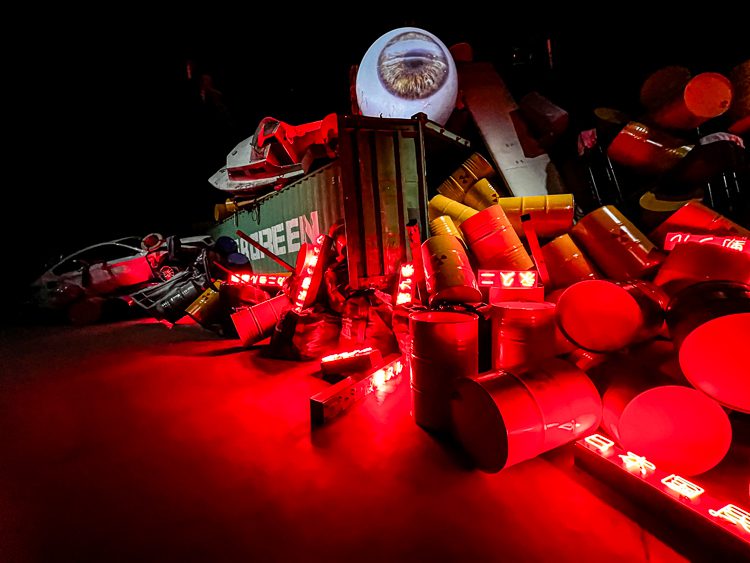
By contrast the main area of PHB is filled with Yukinori Yanagi’s Icarus, a heavy meditation on nuclear war and the systems of governance that humans devise for themselves. Composed of works from the 1990s and 2000s this is a monumental exhibition that includes his famous work from 1993 of a hundred and eighty sand flags slowly being eaten away by a network of ants. Whether large-scale tableaus of nuclear waste drums and a washed up detritus, or a winding passageway of shipping containers, or even a suspended bomb, the scale of Yanagi’s work is expressive and poignant. The power of his work is in how he makes you feel the scale of history as it relates to the individual, the dark tides of humanity that sweep most of us along whether through coercion, choice or chance.

It takes a bold artist to accept a commission at PHB knowing that the centrepiece of the institution is the Anselm Kiefer in the permanent collection. If someone were to put together a list of the seven wonders of the contemporary art world then Kiefer’s The Seven Heavenly Palaces (2004-2015) would surely rank amongst their number. Based on an initiatory route toward enlightenment described in the sefer hecalot, a Hebrew text from the sixth century AD, and housed in a long hanger, the 13-16m tall structures dwarf the average person and walking through them creates a contemplative journey it would require a Sebald to narrate. The small concrete rooms, propped up with lead books stacked on top of each other, seems precarious and solid – at once inviting and yet dangerous to be around. The heart races and the soul is in peril. A jewel in Milan’s crown. A lens through which all other works may be judged. How many works elicit the apex experience of life?
The romance of Milan is so evident that it’s a cliché. But can contemporary art flourish where ancient wonders are resplendent and so bountiful? Is there space for new visions of art to appear amongst the cobbled streets and marble buttresses? Does Milan’s position as a financial powerhouse make it a place for artists, or a place for collectors?
A significant topic that arose repeatedly through Milan Art Week was the effect which Italy’s 22% VAT on art and antiques will have on the art market. Commentators suggest that while galleries might show in Italy they will in fact sell in France, where the tax is 16.5% less (Valentin 2025).
“There is a consortium of different galleries and the official association of Italian Galleries. So there are different bodies that I work with. We all maintain a continuous dialogue between them. We have to as each of these bodies are trying to push forward their own tactics. But we are all coordinated. We are all impacted because I do believe that if we don’t do anything to lower this VAT tax it will put us out of competition, because it’s 22% here, but if you take your car and go 300 kilometers on the left, you’re in France. It’s high (you save 16.5%). It’s crazy, right?
But this is dangerous also for me as a curator, because this has an impact on artists, because if a gallery closes its doors because it cannot compete with a French or German gallery, they won’t support artists and the thousands of other people that galleries employ. However, I understand it’s complicated and if you say I’m gonna lower the VAT tax to a gallery, in the layman’s mind, it’s like, ‘Oh these are rich people, selling works to rich people, and thus lowering the taxes of rich people.’ But what we need to do is approach this as a communal effort and craft a message that this is not just an issue for rich people. This is an issue for young students of the Fine Arts Academy, teachers, and all the workers in the industry.”
At any given time there is a lot of great art in Milan but this year the financial background has given the fair an electric buzz. A national industry showing its metal. Journalists love a noble fight and from Milan Art Week in general, and miart specifically, there’s an ample number of artistic reasons that Milan should continue to grow; however, without economic considerations the future of something as fundamentally commercial as a fair isn’t certain. The upside of such financial stress is that Milan as an artistic community is strengthening its bonds and while such coordinated collaboration survives the open vision of Italian art has a chance to determine its direct path.
Taking place from April 4-6, with the VIP preview held on April 3 at Allianz MiCo, miart is the international modern and contemporary art fair organised by Fiera Milano. Directed by Nicola Ricciardi
miart
international modern and contemporary art fair organized by Fiera Milano
among friends
—
Links:
Milano Art Week
Fondazione Prada
miart
Palazzo Reale
Museo del Novacentro
Refs:
Valentin, P. (2025). VAT rates on art: Europe Moves Forward, Italy Stays Behind. [online] Fieldfisher. Available at: https://www.fieldfisher.com/en/insights/vat-rates-on-art-europe-moves-forward-italy-stays-behind [Accessed 12 Apr. 2025].
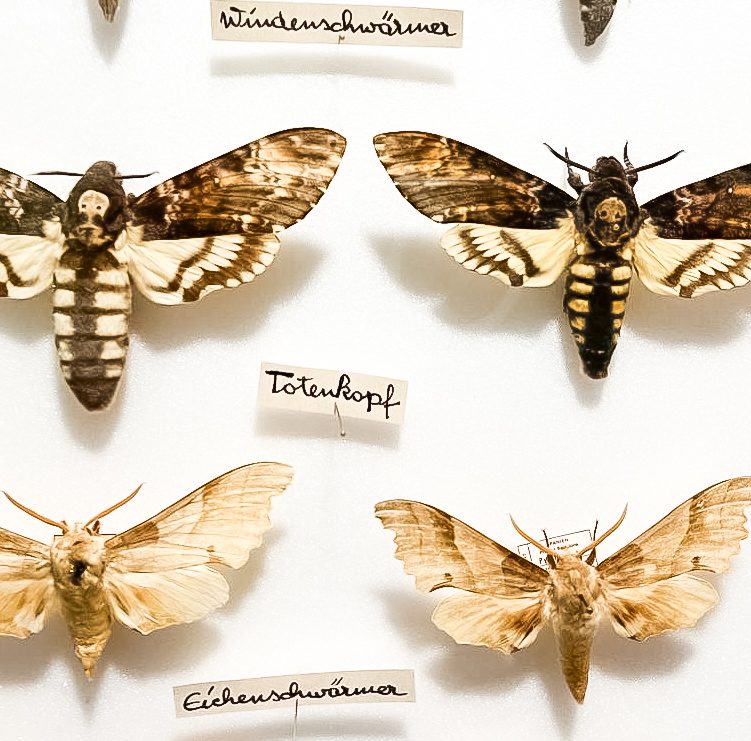
Ex-London based reader of art and culture. Specialist subjects include; media, philosophy, cultural aesthetics, contemporary art and French wine. When not searching for road-worn copies of eighteenth-century travelogues he can be found loitering in the inspirational uplands of art galleries throughout Europe.


